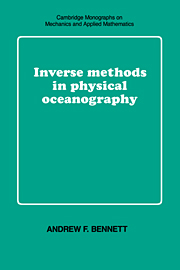Book contents
- Frontmatter
- Contents
- Preface
- 1 Finite-dimensional inverse theory
- 2 The smoothing of observations
- 3 Data assimilation
- 4 The spatial structure of the Kalman filter
- 5 Generalized inverses of dynamical models
- 6 Antenna analysis
- 7 Nonlinear quasi-geostrophic models
- 8 Open-ocean modelling: quasi-geostrophy
- 9 Primitive-equation models
- 10 Outstanding problems
- Bibliography
- Subject index
5 - Generalized inverses of dynamical models
Published online by Cambridge University Press: 08 January 2010
- Frontmatter
- Contents
- Preface
- 1 Finite-dimensional inverse theory
- 2 The smoothing of observations
- 3 Data assimilation
- 4 The spatial structure of the Kalman filter
- 5 Generalized inverses of dynamical models
- 6 Antenna analysis
- 7 Nonlinear quasi-geostrophic models
- 8 Open-ocean modelling: quasi-geostrophy
- 9 Primitive-equation models
- 10 Outstanding problems
- Bibliography
- Subject index
Summary
Introduction
Conventional ocean modeling consists of solving the model equations as accurately as possible, and then comparing the results with observations. While encouraging levels of qualitative agreement have been obtained, as a rule there is significant quantitative disagreement owing to many sources of error: model formulation, model inputs, computation and the data themselves. Computational errors aside, the errors made both in formulating the model and in specifying its inputs usually exceed the errors in the data. Thus it is unsatisfactory to have a model solution which is uninfluenced by the data. In the spirit of the inverse methods in Chapter 1, the approach which is developed here finds the ocean circulation providing the best fit simultaneously to the model equations and to the data. The best fit is defined in a weighted least-squares sense, with weights reflecting prior estimates of the various standard errors. Once unknown errors are explicitly included in the model equations and the data, the problem of finding the circulation is underdetermined, and so the least-squares fit may be regarded as a generalized inverse of the combined dynamics and observing system.
Finding the generalized inverse may also be regarded as a smoothing problem. The smoothing norm involves the differential operators for the model equations as well as derivatives of, or covariances for, the errors or residuals in the equations. Indeed, it is shown that the generalized inverse is equivalent to Gauss-Markov smoothing in space and time, based on the space-time covariance of model solutions forced by random fields having prescribed covariances.
- Type
- Chapter
- Information
- Inverse Methods in Physical Oceanography , pp. 112 - 150Publisher: Cambridge University PressPrint publication year: 1992
- 2
- Cited by



